Separation and purification of metal nanorods using density gradient centrifugation
Abstract
Gold nanoparticles have started to garner attention over the past ten years or so in the field of biomedical science, and particularly in tumor imaging 1, photothermal cancer therapy 2, 3, and metal-enhanced fluorescence. 4 These applications require high-quality gold nanoparticles that are a monodispersion with a uniform size and aspect ratio. In these Application Notes, we will introduce a method to purify a gold nanorod monodispersion from a polydispersion sample using the density gradient centrifugation method with the Avanti JXN-30, which boasts high speeds even amongst high-speed refrigerated centrifuges.
Introduction
Gold nanorods (hereinafter to be abbreviated as AuNR) play an important role in biomedical imaging. AuNR shows extremely strong absorption in the visible light and near-infrared regions as a result of plasmon effects, and it is known that the aspect ratio of AuNR will directly impact the peaks in this absorption wavelength. Therefore, in biomedical imaging, the optical purity of gold nanorods is important as is the physical purity. However, normally, in the AuNR synthesis process, there will be synthesis of gold nanoparticles (gold nanospheres, hereinafter AuNS) with a round shape that failed to become elongated, or of AuNR with an aspect ratio is that slightly different and therefore, less than ideal, as impurities. AuNR and AuNS are the same size, with the same constituent components and the same surface coating (the surfactant CTAB in the majority of cases), so separating them is a major issue. While these nanoparticles have the same sort of size, the density will differ because of slight differences in the surface area / volume ratio. In order to separate nanoparticles with these types of characteristics, density gradient centrifugation can achieve high separative power. In this Application Note, we used two types of AuNR preparation samples. The first sample was AuNR with an aspect ratio of 4.1 (10 nm x 41 nm) and an absorption wavelength of 808 nm, while the second sample was AuNR with an aspect ratio of 2.4 (25 nm x 60 nm) and an absorption wavelength of 650 nm. The two samples were mixed and Avanti JXN30 and a swing rotor (JS-24.15) were used to perform separation via a single density gradient centrifugation operation. The separated AuNR sample was analyzed using a spectrophotometer, and it showed a degree of purification that was the same as that of the original sample.
Protocol
In order to prepare the samples for the density gradient centrifugation using the 10 nm diameter AuNR (absorption wavelength peak at 808 nm, hereinafter to be denoted as AuNR 10 nm) and the diameter 25 nm AuNR (650 nm, hereinafter to be denoted as AuNR 25 nm), 3 mL of each sample was centrifuged using Microfuge 16 (Beckman Coulter) at 10,000 xg for 5 minutes, and the resultant pellets were re-suspended in 0.05 mL of an aqueous 0.01M CTAB solution for concentration. The density gradient was prepared manually as shown in the following table within a 15 mL polyallomer (PA) tube (Serial No. 361707, 31,000 JPY).
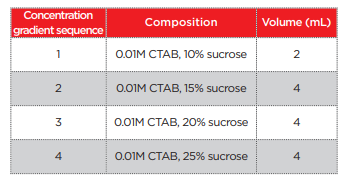
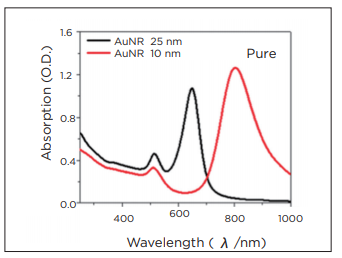
Fig. 1a Absorption spectrum for the AuNR 25 nm and AuNR 10 nm preparations

Fig. 1b Absorption spectrum of the sample containing a mixture of AuNR 25 nm and 10 nm
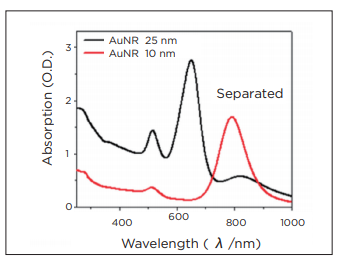
Fig. 2 Absorption spectrum of the sample purified using density gradient centrifugation Density gradient centrifugation was used to separate the mixed sample containing AuNR 25 nm and 10 nm, and the absorption spectrum of each AuNR fraction was measured after purification. AuNR 25 nm AuNR 10 nm AuNR 25 nm AuNR 10 nm Pure Absorption (O.D.) Wavelength ( λ /nm) Mixed Absorption (O.D.) Wavelength ( λ /nm) Separated Absorption (O.D.) Wavelength ( λ /nm) 1.6 1.2 0.8 0.4 0.0 400 600 800 1000 1.0 0.8 0.6 0.4 0.2 0.0 400 600 800 1000 3 2 1 0 400 600 800 1000 10
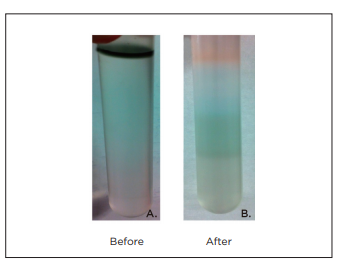
Fig.3 Photographs before and after density gradient centrifugation A) shows the mixed AuNR 25 nm and 10 nm sample prior to density gradient centrifugation, while B) shows a photograph after density gradient centrifugation.
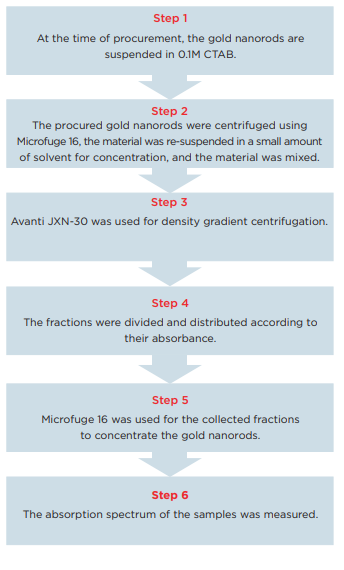
Results and discussion
Fig. 1a shows the absorption spectrum for the preparation, while Fig. 1b shows the absorption spectrum for the mixed sample. AuNR 10 nm showed a main peak at 800 nm and a second peak at 515 nm, as per the theory. Also, AuNR 25 nm showed peaks at 650 nm and 515 nm, as per the theory. The peak ratio for the AuNR 10 nm peaks at 800 nm and 515 nm was 3.85, while the peak ratio for the AuNR 25 nm peaks at 650 nm and 515 nm was 2.32. Fig. 2 shows the absorption spectrum for the sample that was purified using density gradient centrifugation, followed by collection and concentration of the optically identical fractions. The 650 nm/515 nm ratio for the sample concentrated from the fraction with absorption at 650 nm was 1.91, which was approximately the same value as the preparation. Also, it is extremely interesting that the 800 nm/515 nm ratio for the sample that was concentrated from the fraction with absorption at 800 nm was 4.54, and this value was higher than that of the preparation. This demonstrates that impurities were included within even the AuNR sample used as the preparation, and that this material was purified as a result of density gradient centrifugation.
Reagent
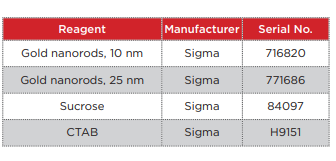
Reference literature
1. Popovtzer R et al. Targeted gold nanoparticles enable molecular CT imaging of cancer. Nano Letters. 8.12; 4593–4596: (2008).
2. Huang X et al. Plasmonic photothermal therapy (PPTT) using gold nanoparticles. Lasers in Medical Science. 23.3; 217–228: (2008).
3. O'Neal D P et al. Photo-thermal tumor ablation in mice using near infrared-absorbing nanoparticles. Cancer Letters. 209.2; 171–176 (2004).
4. Hong G et al. Near-Infrared-Fluorescence-Enhanced Molecular Imaging of Live Cells on Gold Substrates. Angewandte Chemie International Edition. 50.20; 4644–4648: (2011).

